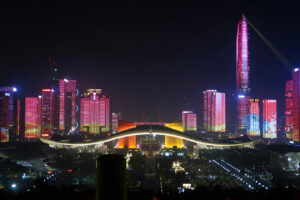By Justine Irish D. Tabile, Reporter
THE Office of the Special Assistant to the President for Investment and Economic Affairs (OSAPIEA) said the government is studying how the “Greater Manila Bay Area” plan proposed by China Ambassador Huang Xilian could complement the US-backed Luzon Economic Corridor economic integration project.
“The development or the concept of a Greater Manila Bay Area … I think it’s an idea. It’s something that can be looked at a little deeper,” Special Assistant to the President Frederick D. Go, who head OSAPIEA, told reporters on the sidelines of the National Retail Conference and Expo.
He said that the proposal could coexist with the Luzon Economic Corridor, which overlaps with areas eyed for the Greater Manila Bay Area.
“I think the idea is to bring about the model of Hong Kong, Macau, Shenzhen, and Guangzhou, and if you look at the Luzon Economic Corridor and the rail that’s being considered, it traverses exactly that corridor — the Manila Bay Area,” he added.
He said that the Chinese proposal came out of a meeting two weeks ago, with another meeting set in two or three months to talk about development of the project.
“The idea will find its roots there in the dialogues between the local federation and the Hong Kong and Macau business associations,” he added.
Asked about the funding, he said that the proposal is still in its very early stages.
“But if they will fund such a study, I think we should welcome it. I think when you have these huge projects, it starts with funding for a study, and then you will do a real masterplan, and then you do the actual implementation,” he said.
The Chinese ambassador proposed the concept of replicating the Guangdong-Hong Kong-Macau Greater Bay Area (GBA) in the cities and provinces around Manila Bay during the Manila Forum for Philippines-China Relations on Aug. 22.
The GBA refers to a cluster of cities in and around the Pearl River Delta being positioned by China for greater economic integration. It consists of Guangzhou, Shenzhen, Zhuhai, Foshan, Dongguan, Zhongshan, Jiangmen, Huizhou, and Zhaoqing.
The cluster recorded $1.98 trillion in gross domestic product last year, making it among the fastest-growing regions in China.
Filipino-Chinese Chambers of Commerce and Industry President Cecilio K. Pedro has said that replicating China’s Greater Bay Area in the Philippines could help attract Chinese investments to the Philippines.
